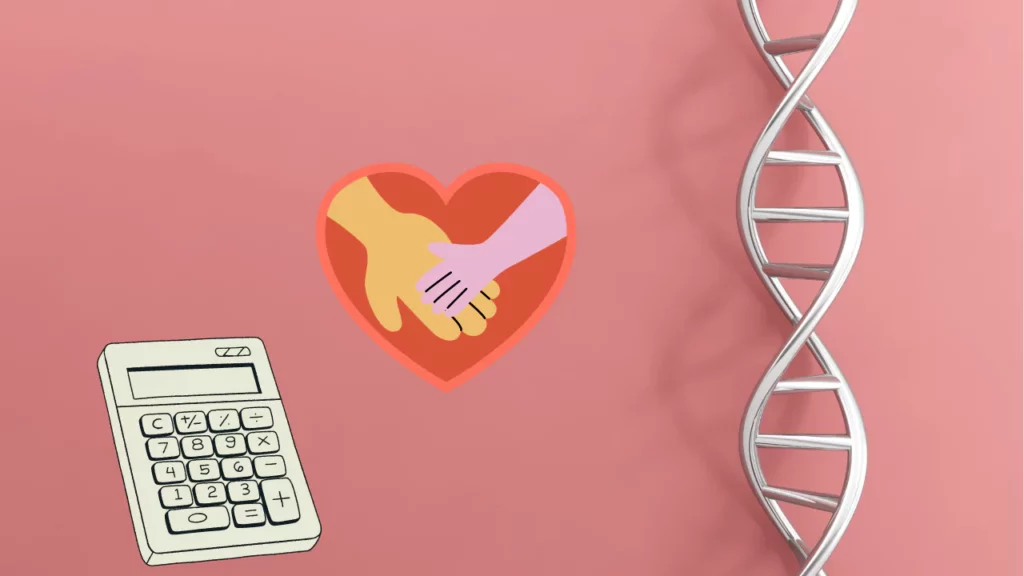Hair color is a fun puzzle to solve before your little one arrives. Our hair color calculator lets you input the parental and grandparental hair colors to forecast your baby’s hair color. Use below hair color predictor to see what the hair color of your future bundle of joy might be.
Child Hair Color Predictor
Select Hair Color of Mother, Father & Grandparents (if known)
Try other genetics calculators:
How This Calculator Works
So you are are curious about what hair color will my child have. Don’t make wild guesses, our tool gives you an estimated glimpse into the genetics that decides your baby’s hair color. It simplifies the vast genetic interactions into a user-friendly format.
While many genes are involved in determining hair color, a few play pivotal roles. The calculator is based on the concept of dominant and recessive genes, similar to eye color. For instance, dark hair is generally dominant over lighter shades and red hair.
Predicting Hair Color
Hair color prediction is a blend of inherited genetic factors from both sides of the family.
When we consider the hair colors of grandparents alongside the parents’, we can unlock a richer, more detailed genetic story.
This additional layer of ancestry provides a clearer picture, though the prediction retains an element of educated speculation due to the complexity and variability of genetic inheritance.
Basics of Hair Color Genetics
At the core of hair color lies melanin, the pigment responsible for the color of our skin, eyes, and hair. The two primary types of melanin in hair are:
- Eumelanin, which dictates shades of black and brown, and
- Pheomelanin, which influences red hair.
The unique blend and concentration of these melanins create a vast spectrum of hair colors observed in humans, from the deepest blacks to the lightest blondes, and the fiery reds.
Dominant vs. Recessive Genes
The narrative of hair color is largely dictated by the dominance of eumelanin-rich genes, making dark hair the more common outcome.
Yet, the presence of recessive genes can change the story, bringing to life the possibility of blonde or red hair, especially when both parents carry and pass these genes to their offspring.
Polygenic Inheritance
Hair color exemplifies polygenic inheritance, a scenario where multiple genes converge to influence a single trait.
This combination of genes make hair color a multifaceted trait rather than the product of a single gene.
Each gene contributes its shade, to the final color we see.
The interaction between these genes, and the dominant-recessive relationships among them, choreographs the unique color of an individual’s hair.
Beyond Black and Brown
While the interplay between eumelanin and pheomelanin sets the stage for the basic hair color categories, the story is far richer.
Variations within these categories – the different shades of brown and blonde, the intensity of red, and even rare colors like auburn or strawberry blonde – highlight the intricate detail of genetic influence.
Moreover, environmental factors and age can also impact hair color over time, adding more complexity to the genetic foundation.
The diversity doesn’t stop at these primary categories; within each, a vast array of shades exists, influenced by the specific combination and density of melanin within the hair shaft.
- Black and Dark Brown Hair: Dominated by high concentrations of eumelanin, black and dark brown hair colors are the most common globally. This abundance of pigment not only gives the hair its color but also contributes to its density and strength. However, even within this commonality, subtle nuances can produce a range of shades from jet black to soft, dark brown, reflecting the variation in eumelanin levels.
- Blonde Hair: The fair shades of blonde result from lower concentrations of eumelanin and are most commonly found in European populations. The specific lightness and hue – from platinum blonde to dark blonde – depend on the minimal presence of this pigment. Genetic variations affecting the production and distribution of eumelanin lead to the wide array of blonde shades seen across populations.
- Red Hair: Perhaps the most fascinating of hair colors, red hair owes its rarity and striking appearance to the presence of pheomelanin. The MC1R gene plays a pivotal role here; variations in this gene influence the amount of pheomelanin produced, giving rise to the spectrum of red from bright copper to deep auburn and strawberry blonde which is inbetween blond and red. Red hair not only stands out due to its color but also its texture and thickness, which differ from other hair colors.
- Brown Hair: Occupying the middle ground of the melanin spectrum, brown hair showcases a balance between eumelanin and pheomelanin. This equilibrium allows for a broad range of shades, from light brown tinged with hints of red or blonde to rich, dark chocolate tones. The specific shade of brown hair is a nuanced reflection of the interplay between the types and amounts of melanin.
A Closer Look at Gene Interaction
Understanding hair color genetics requires a closer look at how specific genes influence melanin production and distribution.
For instance, the MC1R gene plays a crucial role in determining whether an individual will have red hair by influencing the type of melanin produced.
Other genes, such as those in the OCA2 complex, can affect the lightness or darkness of the hair by regulating melanin quantity.
Predicting Hair Color With Calculators
With the help of genetic tools and calculators, predicting a child’s hair color has become a blend of science and anticipation.
By considering the genetic contributions of both parents and grandparents, we can make educated guesses about potential hair colors.
Yet, the beauty of genetics lies in its ability to surprise, reminding us that while science can provide estimates, the diversity of human genetics always holds the potential for unexpected outcomes.
So, our hair color calculator serves as a bridge between genetic science and personal curiosity, yet, keep in mind that there is inherent unpredictability that comes with genetic inheritance.
The sheer number of genes involved in determining hair color, some of which may still be unknown to us, means that the exact shade of a child’s hair can remain a mystery until birth and even evolve over time.
The interaction of multiple genes, coupled with factors such as sunlight exposure and hormonal changes, means that hair color can vary not only among family members but also throughout an individual’s lifetime.
Whether the calculator predicts your child will have hair as dark as the night sky, as golden as the morning sun, or as vibrant as autumn leaves, the true joy lies in the anticipation and eventual discovery of one of the many wonders of genetics.
Frequently Asked Questions
Can Two Blonde Parents Have a Dark-Haired Child?
While the genetics of hair color suggest that two blonde parents are most likely to have children with similarly light hair, the potential for a dark-haired child cannot be completely ruled out. This seeming anomaly can occur due to the polygenic nature of hair color inheritance, where multiple genes contribute to the final phenotype. Mechanism is still not well understood, it may occur due to some new mutations or for some reason brown color gene might be suppressed in parent like in case of eye color, but expressed in the kid. Such instances highlight the complexity of genetic inheritance.
Is Red Hair Rare?
Red hair stands out not just for its striking hue but also for its rarity. Accounting for only 1-2% of the global population, it is the rarest natural hair color. The rarity of red hair is due to the specific genetic requirements for its manifestation. The MC1R gene, responsible for red hair, must be inherited in its variant form from both parents to produce a red-haired child. Since this gene variation is recessive to black/brown hair, the presence of other dominant genes can easily overshadow it, making the occurrence of red hair less common. The gene’s recessive nature, combined with its relatively low prevalence in the global population, explains why red hair is so uncommon.
Can a Child’s Hair Color Change Over Time?
Yes, it’s quite common for children’s hair color to change as they grow. Newborns, for example, often start with lighter hair colors. Over time, the hair may darken due to the increased production of melanin within the hair follicles. This change typically occurs in the first few years of life but can continue into adolescence. Factors influencing this change include genetic programming for hair color that unfolds as a child ages and hormonal changes that affect melanin production. Thus, a baby born with blonde hair could see their hair darken to a brown as they grow.
Reverse is also reported by many parents, when light hair color parents have babies with dark hair and in most such cases kids loose dark color hair over time and have lighter color shade hair throughout life.
How Accurate Are Hair Color Predictors?
Hair color predictors, while innovative and based on genetic principles, offer estimations rather than certainties. The primary reason for this limitation is the complex interplay of multiple genes involved in determining hair color, many of which may exert subtle influences not fully accounted for in simplified models. Additionally, environmental factors and the potential for rare genetic variations mean that predictions are inherently probabilistic. While these tools provide a fun and engaging way to speculate about genetic traits, they should be viewed with the understanding that genetics often holds surprises beyond the scope of current predictive models.

Dr. Sumeet is a seasoned geneticist turned wellness educator and successful financial blogger. GenesWellness.com, leverages his rich academic background and passion for sharing knowledge online to demystify the role of genetics in wellness. His work is globally published and he is quoted on top health platforms like Medical News Today, Healthline, MDLinx, Verywell Mind, NCOA, and more. Using his unique mix of genetics expertise and digital fluency, Dr. Sumeet inspires readers toward healthier, more informed lifestyles.




